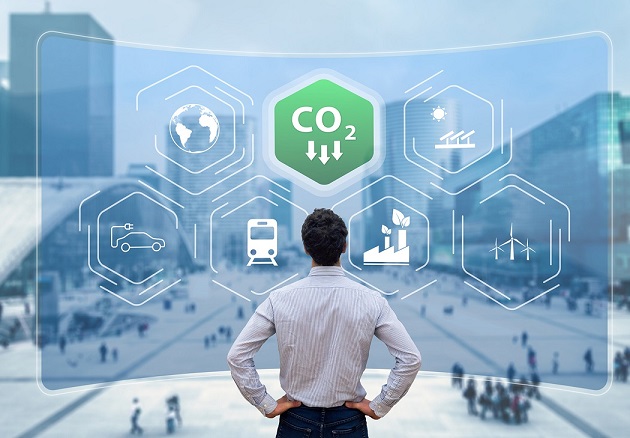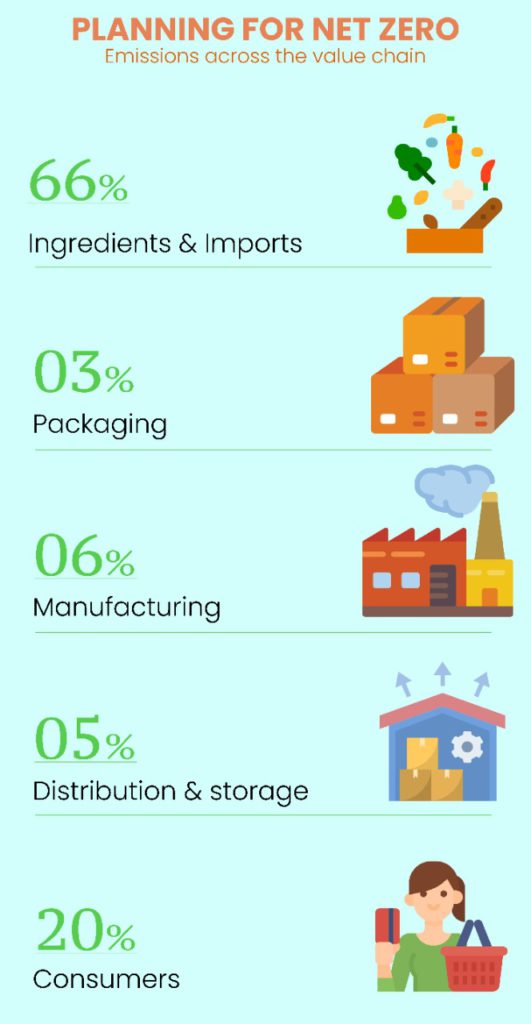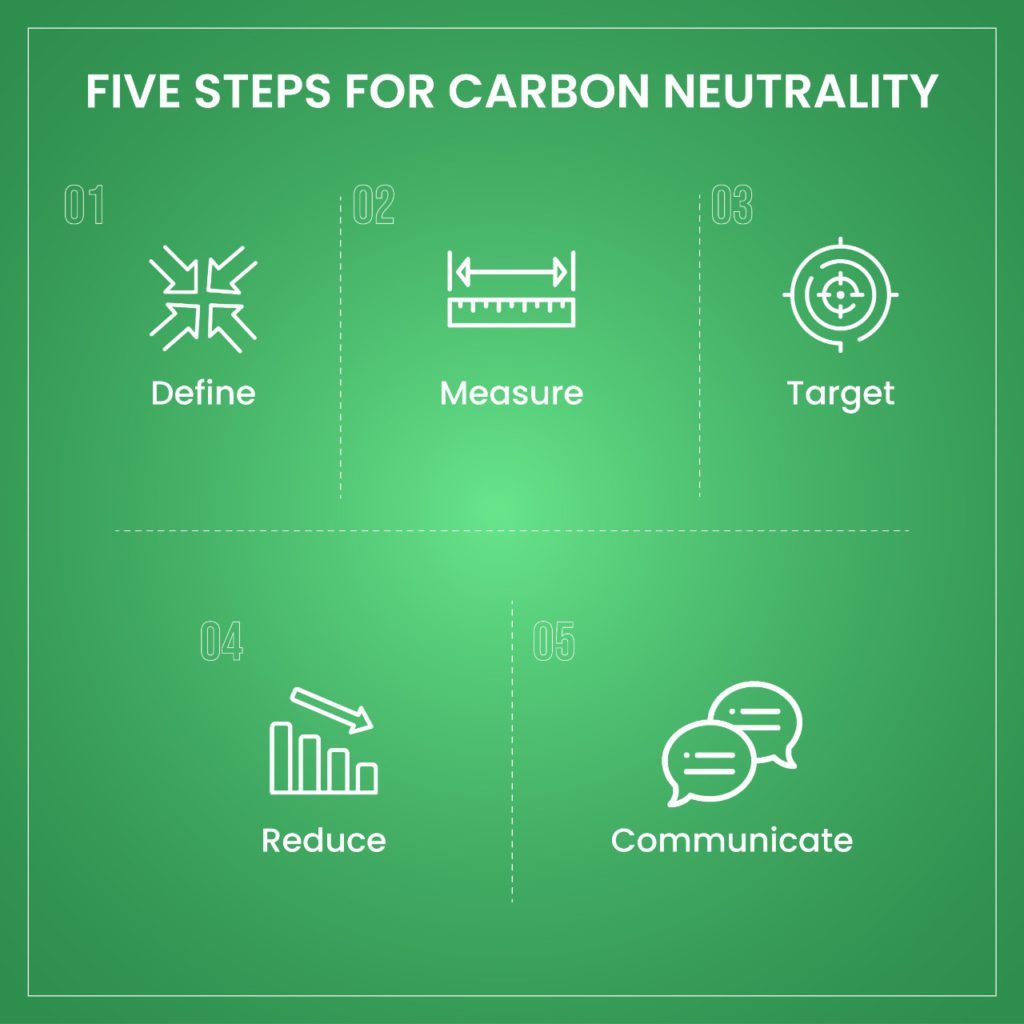Contact: +91 99725 24322 |
Menu
Menu
Quick summary: There is an increasing momentum among organizations to reach the commitments of net-zero and carbon neutrality. However, there are no standard guidelines to achieve the same. You need to avoid green pledges and should be able to measure and verify the emissions and show the world how it is going against your targets. Get your definitions right and start your decarbonization journey!

Unlock the path to net zero by embracing carbon neutrality. Globally countries and companies are pledging to achieve ‘net-zero’ or become ‘ carbon- neutral’ in the next few decades boosting up their climate credentials! In the race to combat climate change and build a sustainable future, the path to net-zero emissions begins with a crucial step- Carbon Neutrality. By achieving carbon neutrality, we can effectively balance the amount of carbon released into the atmosphere with the amount that is removed or offset. It is a vital milestone in the journey to net zero where greenhouse gas emissions are eliminated altogether.
However, net-zero and carbon neutral terms are used interchangeably and misused considerably with no supporting evidence. There are no standard guidelines for achieving net-zero or carbon neutral emissions. Countries and companies seem to be creating their own definitions
Let us get these terminologies right so that it is easy to embark on our ambitious goals and transform them into smart actions.
Our planet has warmed by an average of nearly 1˚C in the past century. According to the global Paris agreement, the temperature rise needs to be kept below 2˚C from the pre-industrial era, with an ambition to keep it below 1.5˚C in order to avert the worst effects of climate change. Temperatures today are rising faster than ever, giving people and wildlife very little time to adapt.
There is a 97% scientific consensus that global warming is man-made, right from burning fossil fuels to deforestation on a huge scale.
What would a rise of 2˚C mean?

The 1.5˚C warming will bring a climate related risk to human health, livelihoods, food security, water supply and economic growth. The livelihoods connected to agriculture and coastal resources will be at the highest risk. Limiting warming to 1.5˚C could reduce the climate related poverty risks by several hundred million by 2050.
The Paris agreement of 2015 clearly defines 2˚C as the upper limit of global warming but lists 1.5˚C as a desirable goal as it reduces the risk of the worst impact of climate change in the world. The IPCC now uses 1.5˚C as a target in its reports. It is under this agreement that countries agreed to make plans to reduce their greenhouse gas emissions. The IPCC demonstrates in its 2018 report that the net emissions must be reduced to zero to stabilize the global temperatures. It reinstates that a reduction to zero is imperative for stopping climate change. These objectives have been ratified by EU, Switzerland and other countries under the Paris agreement. Our planet strongly reacts to small changes in carbon dioxide and other greenhouse gases and it is necessary that these emissions are reduced till the whole system is back in balance.
The global greenhouse gas emissions needs to drop by half by 2030 to reach net zero
The terms net-zero and carbon neutral are used by businesses all along claiming that they have achieved one or the other or even both. These terms are used interchangeably and with inconsistency confusing to figure out what they actually mean.
Net-zero means the global Greenhouse gases from human activity should be in balance with emission reductions. At net-zero, while the carbon dioxide emissions are still generated, an equal amount of carbon dioxide is removed from the atmosphere as is released into it thus resulting in zero increase in net emissions. This would ensure a carbon neutral planet and global temperatures would stabilize.
The food industry must become net-zero to end climate change. With a business-as-usual approach, the emissions could rise by 30 to 40% by 2050. It will be impossible to achieve the Paris agreement goal if no changes are made in the food industry.
The call for organizations, companies and government to bolster commitments to reach net zero emissions are increasing because of a failure to limit climate change. Net zero greenhouse gas targets have become central element for climate action, with businesses rolling out net zero policies and pledges almost on a daily basis. 74 countries accounting for more than 80% of global GDP and 70% of global CO2 emissions have put net-zero commitments in place. As a part of the United Nation’s ‘Race to Zero’ campaign, more than 3000 companies have made net-zero commitments. Many food businesses like Danone, Nestle, McCain and Morrisons have Net zero targets in place. But the change can occur and climatic crisis averted only when all the stakeholders in the supply chain act together.

Nestle is working with farmers and suppliers to improve soil health and enhance biodiversity and limit GHG emissions. Together with this, avoiding deforestation, conserving habitats and reforestation should contribute to Nestle’s net zero roadmap. Nestle hopes to scale the climate change efforts and influence collective action. It aims to halve the GHG emissions by 2030 and achieve a net zero by 2050. Nestle aims to promote a transition towards regenerative food system, thereby making the footprint more transparent. It plans to collaborate with suppliers and improve their production processes. At the other end of the value chain, Nestle plans to encourage consumers with sustainable purchase and consumption.
Unilever, one of the largest food manufacturers in the world wants to shape a global food system that is fair for everyone and plans a transition to healthier and sustainable diets and reduce the environmental impact. The “Future Foods” initiative is set to fulfil these goals. Unilever hopes to achieve a deforestation-free supply chain by 2023 and commit to net zero by 2039 for all the products.
The phrases Net-zero, Climate positive and Carbon Neutrality have been around with more companies pledging for the same. Yet, there is a lack of clarity in these phrases and businesses ought to communicate them more transparently.
Do you know that ‘Carbon Neutral’ was the New Oxford American Dictionary’s word of the year in 2006?
Carbon Neutral is the balance between emitting carbon and absorbing carbon emissions from carbon sinks. According to EU commission, natural sinks remove 9.5-11 Gt of Co2 per year. To be carbon neutral, companies must drastically reduce their carbon emissions to net-zero or balance their emissions through offsetting and purchase of carbon credits.
A number of businesses consider being carbon neutral a key part of their sustainability and CSR strategy while addressing the global climatic crisis. They also realize how important it is to be an environmentally conscious supplier.
A carbon accounting framework is the first step towards achieving carbon neutrality. The calculation and tracking of carbon footprint, implementing cost effective carbon reduction programmes and offsetting emissions with high quality projects are the steps towards carbon neutrality.
Carbon neutrality can be achieved by reforming food systems to minimize GHG emissions and increasing Co2 capture. Also by harnessing the power of renewable resources to produce energy will eliminate dependence on fossil fuels. Protecting natural carbon sinks with soil carbon sequestration should mitigate climate change issues. Management of food systems need to be optimized to increase production efficiency with reduced carbon emissions. Development of technologies for fertilizer production, precision agriculture, regenerative agriculture practices, integrating crop-livestock production systems should help in building sustainable food systems helping climate change.
Carbon neutrality is achieved by a combination of measures inhouse and supporting external emission reduction projects. The Carbon Neutral protocol gives businesses a rigorous framework to deliver carbon neutrality. It is a unifying process to make carbon neutral claims that are recognized globally.
Principles for carbon neutrality

In November 2019, Maple Leaf foods announced that it was the first major food company in the world to become carbon neutral. Maple Leaf foods primarily produces and distributes meat products. It is one of the three main animal protein companies and a Canadian brand to set Science based Targets to align to Paris goals for GHG emissions reduction. Maple Leaf aggressively reduced GHG emissions and invested in high impact environmental projects to offset the remaining emissions. With meat products being high emitters of GHGs, Maple Leaf invested in North American projects to offset its carbon footprint.
Yorkshire tea became carbon neutral after 5 years of supply chain projects. The volume of carbon emitted at each stage of the supply chain from tea bush to wholesale was measured and tea farmers were encouraged to grow fruit and nut trees to soak up carbon and provide shade for wildlife. The company faced many challenges to offset carbon emissions which are generated to the tune of 50,000 tonnes every year.
. Action on climate is no longer nice to have and Carbon Neutrality prepares organizations for a low carbon transformation
Carbon Neutral and Net zero refer to different actions that are necessary to combat climate change.
In a carbon neutral organization, there is a commitment to evaluate the CO2 emissions produced and accordingly find ways to reduce these emissions or compensate by removing them elsewhere. In other words this offsetting could involve planting trees, investing in renewable energy and carbon capture. Carbon neutral accounts only for CO2 emissions and not other GHGs.
Net Zero means that a company reduces its absolute emissions across the supply chain in order to support the target to limit global temperature increase to 1.5˚C as agreed in the Paris agreement.
Net zero is similar to carbon neutrality but is expanded to cover GHGs beyond carbon dioxide. Net zero refers to all GHGs inclusive of methane, nitrous oxide and other hydrofluorocarbons. As with carbon neutrality, to reach net zero, the greenhouse gas emissions emitted into the atmosphere must be equivalent to GHG being removed from atmosphere. Net zero is happening on a global scale which requires collaborative efforts from all sectors. Carbon neutrality is good for businesses to save costs and protect the natural environment.
Boundary - Carbon neutrality has a minimum requirement of covering Scope 1 & 2 emissions with Scope 3 encouraged. Net Zero must cover Scope 1, 2 & 3 emissions.
Level of ambition - there is no requirement for a company to reduce its emissions on a certain trajectory in order to be carbon neutral. To be Net Zero, an organisation must be reducing its emissions along a 1.5ᵒC trajectory across Scopes 1, 2 & 3.
Approach to residual emissions - to achieve carbon neutrality, an organisation must purchase carbon offsets that either result in carbon reductions, efficiencies or sinks. For Net Zero, an organisation must purchase greenhouse gas removals that result in carbon sequestration from the atmosphere.
Though net zero targets represent an opportunity to drive corporate climate action, there is a need to understand the net zero targets. A science-based framework for setting net zero targets is required so that organizations invest in business models that are consistent with goals of the Paris agreement. Through a transparent multi stakeholder process, the Science based targets Initiative (SBTi) developed the first global science-based standard for companies to set net zero targets.
The SBTi’s Net zero standard is the world’s first framework for corporate net-zero target setting in alignment with the climate goals. It includes the guidance and recommendations companies need to set to align their net zero targets with the limiting global temperature rise to 1.5˚C. This standard provides a common robust science-based understanding of net zero and gives organizations a better clarity on their near term and long-term targets that can be aligned to ensure a habitable planet. This standard was developed with expertise from a group of stakeholders and an Advisory group from academia, science and business. It is focussed on accelerating organizations across the world to halve their emissions by 2030 and achieve net zero emissions by 2050.
The initiative is a collaboration between CDP, the United Nations Global Compact, WRI and WWF. It defines and promotes best practices in science-based target setting and provides guidance to reduce barriers to adoption.
Companies must reduce emissions and counterbalance the impact of any emissions that remain. The SBTi standard defines the following steps
Countries need to reduce their GHG emissions and reliance on fossil fuels to minimize effects of climate change. They need to show their commitment to protect the environment and hence companies often claim to be carbon neutral and that their emissions do not contribute to increase in global emission levels. PAS 2060 is an internationally recognized standard designed to verify the accuracy of these claims and help companies achieve carbon neutrality through transparent and credible means.
PAS 2060 is an internationally recognized standard for Carbon Neutrality. It was developed by the British Standards Institution and implemented in 2010. The PAS 2060 presents 4 stages to carbon neutrality
Calculation of corporate carbon footprint including all the scopes using internationally recognized methodologies like GHG corporate protocol or 14064.
Develop a reduction strategy with specific reduction targets and a plan how residual emissions will be offset.
Residual emissions to be offset by high quality certified carbon credits
Disclosure of documentation of carbon neutrality
At the end of this process, companies can get it verified with an independent third party like NQA. Although the standard allows companies to purchase carbon credits, the offsets should meet a criterion and it does not give a guarantee to receive PAS 2060 certification.
PAS 2060 is the only internationally recognized carbon neutrality standard and it allows organizations to demonstrate commitments to climate action.
Benefits
The Greenhouse Gas protocol standard was created through a partnership between the World Resource Institute (WRI) and World Business Council for Sustainable Development (WBSCD). This protocol sets a framework for measuring and managing greenhouse gas emissions and is the world’s widely used greenhouse gas accounting standard. The standard covers accounting and reporting of seven greenhouse gases covered by the Kyoto protocol viz. Carbon dioxide (CO2), Methane (CH4), Nitrous oxide (N2O), Hydrofluorocarbons (HFCs), perfluorocarbons (PCFs), sulphur hexafluoride (SF6) and Nitrogen trifluoride (NF3).
This standard provides requirements and guidance for companies to prepare the GHG inventory. The objectives of these standards are
The GHG protocol has identified two types of emissions
Emissions from Entity owned or controlled sources
Emissions caused by reporting entity’s actions but whose source is not owned or controlled by the reporting entity.
The GHG Protocol also breaks down direct and indirect emissions into three scopes:
Scope 3 emissions is essentially the emissions of a value chain which makes up for 80% of a company’s emissions. Building a scope 3 inventory is quite invaluable for food sector companies. Scope 3 emissions are larger than the two other scopes and are more complicated to measure. Organizations need to specify which scopes they are considering to claim neutrality. While talking about a net-zero strategy, all the three scopes of emissions need to be addressed.
TraceX plays a pivotal role in helping companies achieve carbon neutrality through its robust carbon management solutions. By leveraging blockchain technology and innovative methodologies, Trace Carbon empowers organizations to measure, track and reduce their carbon emissions effectively. Companies can navigate the complexities of carbon neutrality with ease and accelerate their journey towards a sustainable and low carbon future.
It is difficult for organizations to become net-zero due to challenges of reducing scope 3 or supply chain emissions. It is essential that there is collaboration among suppliers so that processes are in place to achieve the long-term emission reductions in line with 1.5˚C pathway. SBTi does approve that zero-emissions scenario is difficult to achieve but organizations claiming to be net-zero must justify the basis on which residual emissions are impossible to reduce. We need to look at the resources provided by SBTi on how to set targets to reduce scope 3 emissions in line with 1.5˚C goals. A carbon roadmap is mandatory to tackle the decarbonization of companies and protect our planet.
